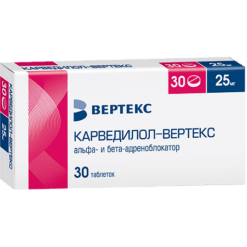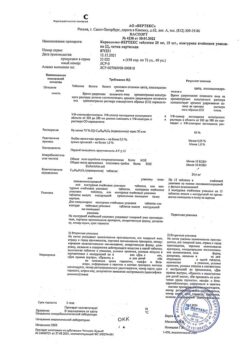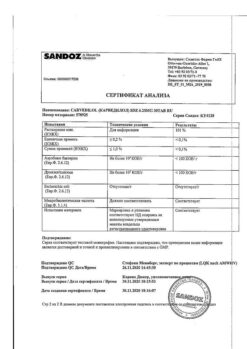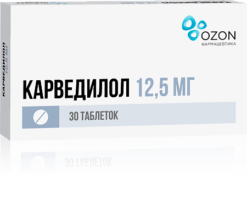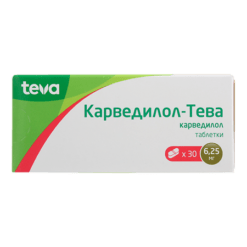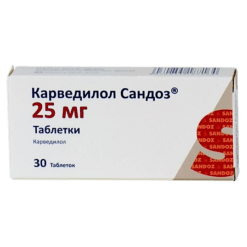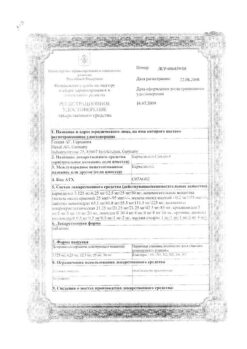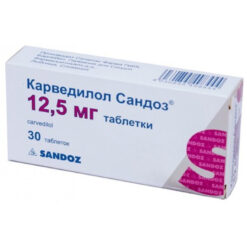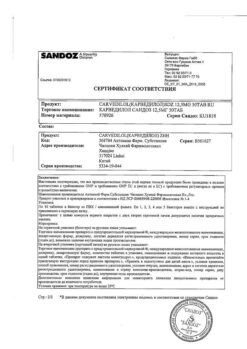No products in the cart.
Sanofi Carvedilol, tablets 12.5mg 30 pcs
€6.15 €5.47
Out of stock
(E-mail when Stock is available)
Description
Carvedilol is a blocker of α1-, β1- and β2-adrenoreceptors, has an organ protective effect, is an antioxidant that eliminates free oxygen radicals, has an antiproliferative effect against smooth muscle cells of vascular walls. It has vasodilatory, antianginal and antiarrhythmic action.
Carvedilol is a racemic mixture of R(+) and S(-) stereoisomers, each with the same a-adrenoblocking properties. The β-adrenoblocking effect of carvedilol is non-selective and is due to the left-handed S(-) stereoisomer. By blocking β-adrenoreceptors, it reduces the activity of the renin-angiotensin-aldosterone system (RAAS), reducing the release of renin, so fluid retention (characteristic of selective α-adrenoblockers) occurs rarely.
The drug has no sympathomimetic activity of its own and has membrane stabilizing properties.
The vasodilatory effect is mainly due to blockade of α1-adrenoreceptors. Through vasodilatation it decreases total peripheral vascular resistance (TPR).
Effectiveness
Arterial hypertension
In patients with arterial hypertension, carvedilol reduces blood pressure (BP) through the combined blockade of β- and α1-adrenoreceptors. Not all of the limitations of traditional β-adrenoblockers apply to carvedilol.
The decrease in BP is not accompanied by the simultaneous increase in total peripheral vascular resistance seen with non-selective α-adrenoblockers.
The heart rate (HR) decreases slightly.
Renal blood flow and renal function are preserved in patients with arterial hypertension.
Carvedilol has been shown not to alter blood stroke volume and to decrease total peripheral vascular resistance (TPR). The drug does not affect blood supply to organs and peripheral blood flow, including skeletal musculature, forearms, lower extremities, skin, brain and carotid artery. Cooling of the extremities and increased fatigue during physical activity are rare.
The antihypertensive effect of carvedilol in arterial hypertension persists for a long time.
Renal dysfunction
Carvedilol is effective in treating patients with renovascular arterial hypertension, including patients with chronic renal insufficiency (CRI), and in patients on hemodialysis or who have undergone a kidney transplant.
Carvedilol causes a gradual decrease in BP on both dialysis and non-dialysis days, with an antihypertensive effect comparable to that of patients with normal renal function.
Based on results obtained in comparative studies in patients on hemodialysis, it has been concluded that carvedilol is more effective and has better tolerability compared to slow calcium channel blockers (CCBs).
Carvedilol reduces morbidity and mortality among patients with cardiomyopathy on dialysis. A meta-analysis of placebo-controlled studies involving a significant number of patients (more than 4,000) with chronic kidney disease confirmed that treating patients with left ventricular dysfunction with or without heart failure symptoms with carvedilol reduces mortality and heart failure events.
Ischemic heart disease
In patients with ischemic heart disease, carvedilol has antiischemic and antianginal effects (increased total exercise capacity, time to ST-segment depression of 1 mm, and time to angina attack) that persist with long-term therapy. Carvedilol significantly reduces myocardial oxygen demand and sympathoadrenal activity. It also reduces preload (pulmonary artery occlusion pressure and pulmonary capillary pressure) and postload (PPS).
Chronic Heart Failure
Carvedilol reduces mortality and hospitalizations, reduces symptoms, and improves left ventricular function in patients with chronic heart failure of ischemic and non-ischemic genesis.
The effects of carvedilol are dose-dependent.
Indications
Indications
– Arterial hypertension
Essential hypertension (in monotherapy or in combination with other hypotensive agents, such as slow calcium channel blockers or diuretics).
– Coronary heart disease (including in patients with unstable angina and myocardial ischemia).
– Chronic heart failure
. Treatment of stable and symptomatic mild, moderate and severe chronic heart failure (NYHA functional class II-IV) of ischemic or non-ischemic genesis in combination with angiotensin-converting enzyme (ACE) inhibitors and diuretics, with or without cardiac glycosides (standard therapy), if not contraindicated.
Active ingredient
Active ingredient
Composition
Composition
One tablet contains:
the active ingredient:
carvedilol – 12.5 mg;
excipients:
sucrose – 12.500,
povidone 30 – 0.600 mg,
lactose monohydrate 200 – 84.865 mg,
silicon dioxide colloid – 0.500 mg,
croscarmellose sodium – 2,300 mg,
magnesium stearate – 1,500 mg,
/p>
iron oxide yellow – 0.230 mg,
iron oxide red – 0.005 mg.
How to take, the dosage
How to take, the dosage
Interaction
Interaction
In concomitant use of antiarrhythmic drugs, anesthetics, antihypertensive drugs, antianginal drugs, other beta-adrenoblockers (including in the form of eye drops) with Carvedilol, there is a risk of undesirable drug interaction.
Concomitant use of CYP2D6 isoenzyme inhibitors may theoretically increase the effect of carvedilol.
Concomitant use of inducers of CYP2D6 isoenzyme system may decrease the effect of carvedilol.
Concomitant use with verapamil, diltiazem for IV administration may cause severe arterial hypotension.
Concomitant use with digoxin may increase the plasma concentration of digoxin and increase the risk of marked bradycardia and AV conduction abnormalities.
Concomitant use of insulin, oral hypoglycemic agents may increase the risk of hypoglycemia.
In concomitant use with clonidine severe bradycardia, arterial hypotension and conduction disorders are possible. In case of abrupt clonidine withdrawal in patients receiving carvedilol, a sharp increase of BP is possible.
Concomitant use with reserpine, MAO inhibitors presents a risk of severe arterial hypotension and bradycardia.
Concomitant use with rifampicin decreases the AUC and Cmax of carvedilol in plasma.
Fluoxetine inhibits the CYP2D6 isoenzyme, which leads to inhibition of carvedilol metabolism and its cumulation. This may increase the cardiodepressant effect (including bradycardia). Fluoxetine and mainly its metabolites are characterized by a long T1/2, so the possibility of drug interaction remains even several days after fluoxetine withdrawal.
Concomitant use with cimetidine increases the AUC of carvedilol without changing its Cmax in plasma.
Concomitant use with cyclosporine may increase (slight to moderate) plasma concentrations of cyclosporine.
Concomitant use with ergotamine derivatives may impair peripheral circulation.
Special Instructions
Special Instructions
With caution, use in patients with CHD and heart failure. Before initiating treatment with carvedilol in heart failure, adequate therapy should be given to eliminate the symptoms of decompensation.
The use of carvedilol in patients with CHF may decrease myocardial oxygen demand (due to blockade of β1-adrenoreceptors). Therefore, withdrawal of carvedilol should be done gradually to avoid the development of angina attacks.
In patients with endocrine disorders, carvedilol may mask symptoms of hyperthyroidism and early signs of acute hyperglycemia (patients with insulin-dependent diabetes should be warned about this).
The use of alcohol is not recommended during treatment.
There is no clinical experience with Carvedilol in pediatrics.
Impact on driving and operating machinery
At the beginning of treatment, as well as when increasing the dose of Carvedilol during treatment, one should refrain from driving and other activities requiring high concentration and quick psychomotor reactions.
Contraindications
Contraindications
– Hypersensitivity to carvedilol or other drug components
– Acute and chronic heart failure in decompensation (NYHA functional class IV) requiring intravenous administration of inotropic agents
– Clinically significant liver function impairment
/p>
– Grade II-III atrioventricular (AV) block (except for patients with an artificial pacemaker)
– Severe bradycardia (HR less than 50 bpm)
– Sinus node weakness syndrome (including sinoatrial block)
– Severe arterial hypotension (systolic BP less than 85 mmHg. Hg.)
– Cardiogenic shock
– Bronchospasm and bronchial asthma (history)
– Pheochromocytoma (without concomitant use of α-adrenoblockers)
– Age under 18 years (effectiveness and safety not established)
– Pregnancy and breastfeeding
– Fructose intolerance, lactose intolerance, lactase, sucrose/isomaltase deficiency, glucose-galactose malabsorption (drug contains lactose and sucrose)
Chronic obstructive pulmonary disease (COPD), Prinzmetal angina, thyrotoxicosis, peripheral vascular occlusive disease, suspected pheochromocytoma, psoriasis, renal failure, grade I atrioventricular block, extensive surgery and general anesthesia, diabetes, hypoglycemia, depression, myasthenia.
Side effects
Side effects
Cardiovascular system disorders: at the beginning of treatment (effect of the first dose) and when increasing the dose, episodes of excessive BP decrease are possible (usually these phenomena pass on their own and the patient’s condition stabilizes without special correction); during further use of Carvedilol bradycardia is also possible; rarely peripheral blood flow disorders, angina attacks, AV-blockade, episodes of intermittent claudication are observed; in individual cases – increase of manifestations of heart failure.
CNS and peripheral nervous system disorders: weakness, fatigue, headache; in some cases – sleep disorders, mental depression, paresthesia.
Digestive system disorders: increase in intestinal tone and motility; in some cases – changes in plasma transaminase activity.
Allergic reactions: rare – allergic exanthema, itching.
Dermatological reactions: urticaria, reactions resembling lichen planus, appearance of psoriatic plaques or exacerbation of pre-existing psoriatic process.
Respiratory system disorders: in some cases – nasal congestion.
Hematopoietic system: in some cases – thrombocytopenia, leukopenia.
Similarities
Similarities
Additional information
| Manufacturer | Zentiva k.s., Czech Republic |
|---|---|
| Medication form | pills |
| Brand | Zentiva k.s. |
Other forms…
Related products
Buy Sanofi Carvedilol, tablets 12.5mg 30 pcs with delivery to USA, UK, Europe and over 120 other countries.


